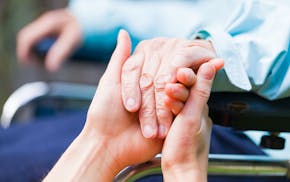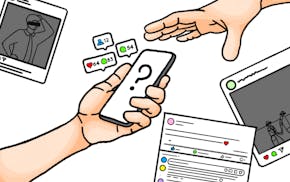Opinion editor's note: Strib Voices publishes a mix of material from 11 contributing columnists, along with other commentary online and in print each day. To contribute, click here.
•••
I've been wanting to find a way to write about homelessness for several months now, undertaking hours of research and interviews. I've waded through data and articles about encampments and policy changes, about defunding and about increased initiatives.
So many people have tried so many different things, and just as soon as something seems to be working, another problem pops up. What is there left to say? For an exhausted and overwhelmed American populace, the imperative for compassion and charity has been all but burned out. Well-meaning do-gooders have sometimes seen their efforts fall flat, or their funds misused by scammers or profiteers.
What then do we say in the midst of a problem so intractable no one knows quite what to call people experiencing it anymore. Houseless? Homeless? Unhoused?
I think part of the reason the most popular framing for people to think about the problem of homelessness is to show footage of Minneapolis encampments and tents on Skid Row is that doing so makes it obvious and inherently "other." Homelessness and its accompanying problems are visible and abhorrent in places where drug use and violence are at the center of everyday life.
Viewing homelessness through this lens enables most of us to think: "Well, obviously, that would never be me. I could never live that way. And most of the people who are there, well, they must want to live that way. And of course they're doing drugs. And likely mentally ill …"
As those who work with people experiencing homelessness know all too well, though, no one decides one morning, out of the blue, that they're going to go and live in an encampment. Living on the streets is never the first step someone takes into homelessness. Rather, many people spend their entire lives on the edge of homelessness, beginning as children born into families living in poverty. For others, rising prices and circumstances out of their control — a layoff, a large hospital bill, a cancer diagnosis, the death of a caregiver — quickly spiral, and people find themselves out of options, often after couch surfing for a while with family or friends, and sometimes living in their cars.
Much as the American ethos might want us to believe that homelessness, like the American dream of success, is somehow earned, most of it is actually based on birth and luck. There but for the grace of God go I. Or maybe more accurately, there but for luck and timing go I, for the God of the Bible makes clear that God does not judge those who are without shelter but instead stands in solidarity with them, compelling all who want to follow God to serve those in need as God's chosen ones.
When I talked with Soren Stevenson, a street outreach worker at Agate Housing and Services who's also running for Minneapolis City Council, he told me that the most common story he sees of people falling into homelessness is women, often mothers, who experience domestic violence in their homes, at the hands of a partner who's often also the father of their children.
In Minneapolis, Stevenson said, domestic violence shelters are almost always full, leaving these women with a choice of staying with someone they know, someone they don't know, going back to their abuser or staying outside, maybe in a vehicle. The fear and vulnerability that go along with such a desperate situation do not fit neatly into a narrative about addicts who "choose" to live outdoors. And women in this situation are also almost always invisible to the everyday public, for reasons of safety. Too often, their lives and their stories are erased or deemed unimportant.
In one small step toward beating back the scourge of homelessness, Stevenson said he wants everyone in Minnesota to simply open their eyes to see the women who might be suffering domestic violence in our midst. Be compassionate and patient, even with someone who might seem standoffish or angry. She might not be allowed to interact with people outside her household, and she might be controlled financially and socially by her abuser. Building trusting relationships outside the home could help her and her children escape without resorting to the danger of living on the streets.
As Stevenson recounted more stories, including one of a Native elder who'd overcome the loss of his partner, historical trauma, deep depression and grief to move into stable housing and find work, it was clear that the path in and out of homelessness is marked by connections and relationships and community — the presence and loss of each helping people to dig their way out, or slip through the cracks again and again.
Perhaps for this reason Monica Nilsson, who has worked in the field of homelessness in Minnesota for more than 30 years, told me that the most important thing she thinks people can offer to those in need is not merely money or food. In her work, she sees their deepest suffering coming not from lack of food or money but from lack of genuine human contact and connection.
I think back to when I saw for the first time a person living on the streets, or panhandling with a sign. I recall similar experiences with my kids, years ago when we lived in Southern California and also here in Minnesota. Our basic human instinct is to interact, to show compassion, to reach out.
But after years of my own experience as a pastor and a person working in the weeds of housing policy or assistance programs designed to help people experiencing homelessness, I'd become wary of cash or food handouts to individuals, realizing the ways in which our intended charity sometimes further entrenches patterns of despair and isolation.
Nilsson says that when people ask her what to do in those situations, she tells people that it's important to work to support the people and organizations who are working to be present every day in peoples' lives to help them get back on their feet.
But then she does something even more significant. Instead of rolling up her window and looking away when people ask her for help, Nilsson extends her hand to the person who has asked her for help, to touch skin to skin and shake hands.
The human gesture expresses connection, vulnerability, and maybe reminds both parties that we need each other more than we need anything else.
•••
Many organizations that work with homeless individuals are vulnerable to budget cuts under the new federal administration, threatening the weathered safety net that exists for people experiencing homelessness in Minnesota. You can donate to support these local organizations on their websites, or sign up to volunteer.

Rash: At home, Jake Sullivan reflects on events abroad

Opinion: Let's not lose sight of what's best for older adults

Readers Write: Minneapolis politics, Trump's budget, hot tub rentals
